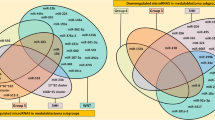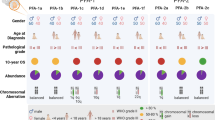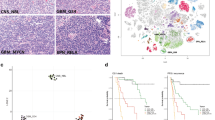Abstract
Purpose
In neurogenesis, ASPM (abnormal spindle-like microcephaly-associated) gene is expressed mainly in the ventricular zone of posterior fossa and is the major determinant in the cerebral cortex. Besides its role in embryonic development, ASPM overexpression promotes tumor growth, including central nervous system (CNS) tumors. This study aims to investigate ASPM expression levels in most frequent posterior fossa brain tumors of childhood and adolescence: medulloblastoma (MB), ependymoma (EPN), and astrocytoma (AS), correlating them with clinicopathological characteristics and tumor solid portion size.
Methods
Quantitative reverse transcription (qRT-PCR) is used to quantify ASPM mRNA levels in 80 pre-treatment tumor samples: 28 MB, 22 EPN, and 30 AS. The tumor solid portion size was determined by IOP-GRAACC Diagnostic Imaging Center. We correlated these findings with clinicopathological characteristics and tumor solid portion size.
Results
Our results demonstrated that ASPM gene was overexpressed in MB (p = 0.007) and EPN (p = 0.0260) samples. ASPM high expression was significantly associated to MB samples from patients with worse overall survival (p = 0.0123) and death due to disease progression (p = 0.0039). Interestingly, two patients with AS progressed toward higher grade showed ASPM overexpression (p = 0.0046). No correlation was found between the tumor solid portion size and ASPM expression levels in MB (p = 0.1154 and r = − 0.4825) and EPN (p = 0.1108 and r = − 0.3495) samples.
Conclusion
Taking in account that ASPM gene has several functions to support cell proliferation, as mitotic defects and premature differentiation, we suggest that its overexpression, presumably, plays a critical role in disease progression of posterior fossa brain tumors of childhood and adolescence.




Similar content being viewed by others
References
Bon J et al (2002) ASPM is a major determinant of cerebral cortical size. Nat Genet 32(2):316–320. https://doi.org/10.1038/ng995
Zhang J (2003) Evolution of the human ASPM gene, a major determinant of brain size. Genetics 165(4):2063–2070
Fujimori A, Itoh K, Goto S, Hirakawa H, Wang B, Kokubo T, Kito S, Tsukamoto S, Fushiki S (2013) Disruption of ASPM causes microcephaly with abnormal neuronal differentiation. Brain Dev 36(8):661–669. https://doi.org/10.1016/j.braindev.2013.10.006
Fish JL, Kosodo Y, Enard W, Pääbo S, Huttner WB (2006) ASPM specifically maintains symmetric proliferative divisions of neuroepithelial cells. Proc Natl Acad Sci 103(27):10438–10443. https://doi.org/10.1073/pnas.0604066103
Penisson M, Ladewig J, Belvindah R, Francis F (2019) Genes and mechanisms involved in the generation and amplification of basal radial glial cells. Front Cell Neurosci 13:381. https://doi.org/10.3389/fncel.2019.00381
Vulcani-Freitas TM, Saba-Silva N, Cappellano A, Cavalheiro S, Marie SKN, Oba-Shinjo SM, Malheiros SMF, de Toledo SRC (2011) ASPM gene expression in medulloblastoma. Childs Nerv Syst 27:71–74. https://doi.org/10.1007/s00381-010-1252-5
Williams SE, Garcia I, Crowther AJ, Li S, Stewart A, Liu H, Lough KJ, O'Neill S, Veleta K, Oyarzabal EA, Merrill JR, Shih YYI, Gershon TR (2015) ASPM sustains postnatal cerebellar neurogenesis and medulloblastoma growth. Development 142(22):3921–3932. https://doi.org/10.1242/dev.124271
Horvath S et al (2006) Analysis of oncogenic signaling networks in glioblastoma identifies ASPM as a molecular target. Proc Natl Acad Sci U S A 103(46):17402–17407. https://doi.org/10.1073/pnas.0608396103
Lin SY, Pan HW, Liu SH, Jeng YM, Hu FC, Peng SY, Lai PL, Hsu HC (2008) ASPM a novel marker for vascular invasion, early recurrence, and poor prognosis of hepatocellular carcinoma. Clin Cancer Res 14(15):4814–4820. https://doi.org/10.1158/1078-0432.CCR-07-5262
Brüning-Richardson A, Bond J, Alsiary R, Richardson J, Cairns DA, McCormack L, Hutson R, Burns P, Wilkinson N, Hall GD, Morrison EE, Bell SM (2011) ASPM and microcephalin expression in epithelial ovarian cancer correlates with tumor grade and survival. Br J Cancer 104:1602–1610. https://doi.org/10.1038/bjc.2011.117
Wang WY et al (2013) A gene expression signature of epithelial tubulogenesis and a role for ASPM in pancreatic tumor progression. Gastroenterology 145(5):1110–1120. https://doi.org/10.1053/j.gastro.2013.07.040
Pai VC, Hsu CC, Chan TS, Liao WY, Chuu CP, Chen WY, Li CR, Lin CY, Huang SP, Chen LT, Tsai KK (2019) ASPM promotes prostate cancer stemness and progression by augmenting Wnt-Dvl-3-β-catenin signaling. Oncogene 38(8):1340–1353. https://doi.org/10.1038/s41388-018-0497-4
Timaner M, Shaked Y (2019) Elucidating the roles of ASPM isoforms reveals a novel prognostic marker for pancreatic cancer. J Pathol 250:123–125. https://doi.org/10.1002/path.5355
Liu X, Li J, Ren F (2019) Identification and integrated analysis of key biomarkers for diagnosis and prognosis of non-small cell lung Cancer. Med Sci Monit 25:9280–9289. https://doi.org/10.12659/MSM.918620
Wei W, Lv Y, Gan Z, Zhang Y, Han X, Xu Z (2019) Identification of key genes involved in the metastasis of clear cell renal cell carcinoma. Oncol Lett 17(5):4321–4328. https://doi.org/10.3892/ol.2019.10130
Xu Z, Zhang Q, Luh F, Jin B, Liu X (2019) Overexpression of the ASPM gene is associated with aggressiveness and poor outcome in bladder cancer. Oncol Lett 17(2):1865–1876. https://doi.org/10.3892/ol.2018.9762
Li L, Peng M, Xue W, Fan Z, Wang T, Lian J, Zhai Y, Lian W, Qin D, Zhao J (2018) Integrated analysis of dysregulated long non-coding RNAs/microRNAs/mRNAs in metastasis of lung adenocarcinoma. J Transl Med 16(1):372. https://doi.org/10.1186/s12967-018-1732-z
Schiewek J et al (2018) Clinical relevance of cytoskeleton associated proteins for ovarian cancer. J Cancer Res Clin Oncol 144(11):2195–2205. https://doi.org/10.1007/s00432-018-2710-9
Liu L, Chen F, Xiu A, Du B, Ai H, Xie W (2018) Identification of key candidate genes and pathways in endometrial cancer by integrated bioinformatical analysis. Asian Pac J Cancer Prev 19(4):969–975. https://doi.org/10.22034/APJCP.2018.19.4.969
Wang F, Li J, Liu J, Zhao Q (2017) Controversial role of the possible oxyntic stem cell marker ASPM in gastric cancer. J Pathol 241(4):559–561. https://doi.org/10.1002/path.4863
Weinberger P, Ponny SR, Xu H, Bai S, Smallridge R, Copland J, Sharma A (2017) Cell cycle M-phase genes are highly upregulated in anaplastic thyroid carcinoma. Thyroid 27(2):236–252. https://doi.org/10.1089/thy.2016.0285
Choi EJ, Kim MS, Yoo NJ, Lee H (2016) Frameshift mutation of ASPM gene in colorectal cancers with regional heterogeneity. Pathol Oncol Res 22(4):877–879. https://doi.org/10.1007/s12253-016-0108-z
Cheng F, Zhao J, Fooksa M, Zhao Z (2016) A network-based drug repositioning infrastructure for precision cancer medicine through targeting significantly mutated genes in the human cancer genomes. J Am Med Inform Assoc 23(4):681–691. https://doi.org/10.1093/jamia/ocw007
Vange P, Bruland T, Beisvag V, Erlandsen SE, Flatberg A, Doseth B, Sandvik AK, Bakke I (2015) Genome-wide analysis of the oxyntic proliferative isthmus zone reveals ASPM as a possible gastric stem/progenitor cell marker over-expressed in cancer. J Pathol 237(4):447–459. https://doi.org/10.1002/path.4591
Kuo WY, Wu CY, Hwu L, Lee JS, Tsai CH, Lin KP, Wang HE, Chou TY, Tsai CM, Gelovani J, Liu RS (2015) Enhancement of tumor initiation and expression of KCNMA1, MORF4L2 and ASPM genes in the adenocarcinoma of lung xenograft after vorinostat treatment. Oncotarget 6(11):8663–8675. https://doi.org/10.18632/oncotarget.3536
Alsiary R, Brüning-Richardson A, Bond J, Morrison EE, Wilkinson N, Bell SM (2014) Deregulation of microcephalin and ASPM expression are correlated with epithelial ovarian cancer progression. PLoS One 9(5):e97059. https://doi.org/10.1371/journal.pone.0097059
Peyre M, Commo F, Dantas-Barbosa C, Andreiuolo F, Puget S, Lacroix L, Drusch F, Scott V, Varlet P, Mauguen A, Dessen P, Lazar V, Vassal G, Grill J (2010) Portrait of Ependymoma recurrence in children biomarkers of tumor progression identified by dual-color microarray-based gene expression analysis. PLoS One 5(9):e12932. https://doi.org/10.1371/journal.pone.0012932
Marie SK et al (2008) Maternal embryonic leucine zipper kinase transcript abundance correlates with malignancy grade in human astrocytomas. Int J Cancer 122(4):807–815. https://doi.org/10.1002/ijc.23189
Chintagumpala M, Gajjar A (2015) Brain tumors. Pediatr Clin N Am 62(1):167–178
Ostrom QT, Gittleman H (2015) CBTRUS statistical report: primary brain and central system tumors diagnosed in the United States in 2008-2012. Neuro Oncol 17(Suppl 4):iv1–iv62. https://doi.org/10.1093/neuonc/nov189
Banan R, Hartmann C (2016) The new WHO 2016 classification of brain tumors – what neurosurgeons need to know. Acta Neurochir 159(3):403–418. https://doi.org/10.1007/s00701-016-3062-3
Castillo M (2010) Stem cells, radial glial cells, and a unified origin of brain tumors. Am J Neuroradiol 31(3):389–390. https://doi.org/10.3174/ajnr A1674
Barry DS (2014) Radial glial cells: key organisers in CNS development. Int J Biochem Cell Biol 76:–79. https://doi.org/10.1016/j.biocel.2013.11.013
Livak KJ, Schmittgen TD (2001) Analysis of relative gene expression data using real-time quantitative PCR and the 2(−Delta Delta C(T)) method. Methods 25(4):402–408. https://doi.org/10.1006/meth.2001.1262
Takebayashi R et al (2013) [18F] Fluorodeoxyglucose accumulation as a biological marker of hypoxic status but not glucose transport ability in gastric cancer. J Exp Clin Cancer Res 32:34. https://doi.org/10.1186/1756-9966-32-34
Mikirova N, Scimeca CR (2016) Gene expression response to ascorbic acid in mice implanted with sarcoma S180 cells. J Transl Sci. https://doi.org/10.15761/JTS.1000132
Che L, Yuan YH, Jia J, Ren J (2012) Activation of sonic hedgehog signaling pathway is an independent potential prognosis predictor in human hepatocellular carcinoma patients. Chin J Cancer Res 24(4):323–331. https://doi.org/10.3978/j.issn.1000-9604.2012.10.10
Helmke BM, Markowski DN, Muller MH, Sommer A, Muller J, Moller C, Bullerdiek J (2010) HMGA proteins regulate the expression of FGF2 in uterine fibroids. Mol Hum Reprod 17(2):135–142. https://doi.org/10.1093/molehr/gaq083
Ke D, Yang R, Jing L (2018) Combined diagnosis of breast cancer in the early stage by MRI and detection of gene expression. Exp Ther Med 16:467–472. https://doi.org/10.3892/etm.2018.6242
Kondo T et al (2004) High expression of chemokine gene as a favorable prognostic factor in renal cell carcinoma. J Urol 171:2171–2175. https://doi.org/10.1097/01.ju.0000127726.25609.87
Johnson MB, Sun X, Kodani A, Borges-Monroy R, Girskis KM, Ryu SC, Wang PP, Patel K, Gonzalez DM, Woo YM, Yan Z, Liang B, Smith RS, Chatterjee M, Coman D, Papademetris X, Staib LH, Hyder F, Mandeville JB, Grant PE, Im K, Kwak H, Engelhardt JF, Walsh CA, Bae BI (2018) ASPM knockout ferret reveals an evolutionary mechanism governing cerebral cortical. Nature 556:370–375. https://doi.org/10.1038/s41586-018-0035-0
Bikeye SN, Colin C, Marie Y, Vampouille R, Ravassard P, Rousseau A, Boisselier B, Idbaih A, Calvo C, Leuraud P, Lassalle M, el Hallani S, Delattre JY, Sanson M (2010) ASPM-associated stem cell proliferation is involved in malignant progression of gliomas and constitutes an attractive therapeutic target. Cancer Cell Int 10:1. https://doi.org/10.1186/1475-2867-10-1
Sturm D, Pfister SM, Jones DTW (2017) Pediatric Gliomas: current concepts on diagnosis, biology, and clinical management. J Clin Oncol 35(21):2370–2377. https://doi.org/10.1200/JCO.2017.73.0242
Kozera B, Rapacz M (2013) Reference genes in real-time PCR. J Appl Genet 54(4):391–406. https://doi.org/10.1007/s13353-013-0173-x
Cavalli FMG et al (2017) Intertumoral heterogeneity within medulloblastoma subgroups. Cancer Cell 31(6):737–754.e6. https://doi.org/10.1016/j.ccell.2017.05.005
Schwalbe EC et al (2017) Novel molecular subgroups for clinical classification and outcome prediction in childhood medulloblastoma: a cohort study. Lancet Oncol 18(7):958–971. https://doi.org/10.1016/S1470-2045(17)30243-7
Dewi FRP et al (2020) Nucleoporin TPR (translocated promoter region, nuclear basket protein) upregulation alters MTOR-HSF1 trails and suppresses autophagy induction in ependymoma. J Autophagy:1554–8635. https://doi.org/10.1080/15548627.2020.1741318
Bergström T, Forsberg-Nilsson K (2012) Neural stem cells: brain building blocks and beyond. Ups J Med Sci 117(2):132–142. https://doi.org/10.3109/03009734.2012.665096
Funding
This work was supported by grants from FAPESP (The State of São Paulo Research Foundation: 2017/26902-1) and IOP-GRAACC/UNIFESP (Grupo de Apoio ao Adolescente e à Criança e com Câncer).
Author information
Authors and Affiliations
Corresponding author
Ethics declarations
Conflict of interest
The authors declare that they have no conflict of interest.
Ethical approval
All procedures performed in studies involving human participants were in accordance with the ethical standards of the institutional research committee (Research Ethics Committee—Federal University of São Paulo no. 0525/2018) and with the 1964 Helsinki declaration and its later amendments or comparable ethical standards. This article does not contain any studies with animals performed by any of the authors.
Informed consent
Samples from each primary tumor and healthy brain were collected after informed consent was signed by patients/guardians according to the institutional research committee (Research Ethics Committee—Federal University of São Paulo no. 0525/2018). The biological material is acquired via a Biobank of the Pediatric Oncology Institute-GRAACC/UNIFESP (B-053).
Additional information
Publisher’s note
Springer Nature remains neutral with regard to jurisdictional claims in published maps and institutional affiliations.
Rights and permissions
About this article
Cite this article
Cabral de Carvalho Corrêa, D., Dias Oliveira, I., Mascaro Cordeiro, B. et al. Abnormal spindle-like microcephaly-associated (ASPM) gene expression in posterior fossa brain tumors of childhood and adolescence. Childs Nerv Syst 37, 137–145 (2021). https://doi.org/10.1007/s00381-020-04740-1
Received:
Accepted:
Published:
Issue Date:
DOI: https://doi.org/10.1007/s00381-020-04740-1




